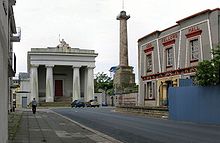- Devonport, Devon
-
Coordinates: 50°22′21″N 4°10′22″W / 50.3725°N 4.172778°W
Devonport 
Devonport skyline
 Devonport shown within Devon
Devonport shown within DevonOS grid reference SX455547 Unitary authority Plymouth Ceremonial county Devon Region South West Country England Sovereign state United Kingdom Post town PLYMOUTH Postcode district PL1 Dialling code 01752 Police Devon and Cornwall Fire Devon and Somerset Ambulance South Western EU Parliament South West England UK Parliament Plymouth Sutton Devonport List of places: UK • England • Devon Devonport, formerly named Plymouth Dock or just Dock,[1] is a district of Plymouth in the English county of Devon, although it was, at one time, the more important settlement. It became a county borough in 1889. Devonport was originally one of the "Three Towns" (along with Plymouth and East Stonehouse); these merged in 1914 to form what would become in 1928 the City of Plymouth. It is represented in the Parliament of the United Kingdom as part of the Plymouth Sutton and Devonport constituency. Its elected Member of Parliament (MP) is Oliver Colvile, who is affiliated with the Conservative Party.
Contents
History
In 1690 the Admiralty gave a contract to Robert Waters from Portsmouth to build a stone dock at Point Froward on the east bank of the Hamoaze at the mouth of the River Tamar. Plymouth Dock, as Devonport was originally called, began around 1700 as a small settlement to house workers employed on the new naval base that was being built around Waters' dock.[2] By 1733 its population had grown to around 3,000,[3] and by 1801 it was already larger than both the nearby towns of Plymouth and Stonehouse together.[4]
By 1811 the population of Plymouth Dock was just over 30,000 and the residents resented the fact that its name made it sound like an adjunct of Plymouth. In 1823 a petition to King George IV requested the town should be renamed, and suggested "Devonport". The king agreed,[5] and to celebrate, the town built a column next to the recently-completed town hall; both were designed by John Foulston.[1] Devonport was first incorporated as a municipal borough in 1837 under the Municipal Corporations Act 1835. It became a county borough under the Local Government Act 1888.
21st century Devonport
During the millennium decade, Devonport received government NDC (New Deals for Communities) funding of £48.7 million; this enabled an extensive Regeneration programme to be carried out. Since 2009, the investments have begun to transform Devonport - physically, socially, demographically. Where once the area was run-down, depressed, and classified as ‘deprived’ in many categories, the 21st-century Devonport is beginning to achieve the city’s vision of … “The recreation of Devonport as a distinct place in modern Plymouth; a vibrant self sustaining community; a place of real quality, variety and interest, the pride of residents, attractive to visitors and a model of 21st Century living, working and playing.”[citation needed]
The Admiralty's release of several land plots in Devonport has assisted the Regeneration project. One ex-MoD area, where new homes will be available from 2011, is the Admiralty House site at Mount Wise. Although there are pockets of regeneration work remaining to be completed, the waterfront district of Devonport is becoming one of the desired residential areas of the city of Plymouth. [6]
In 2011, the Devonport Heritage Trail was introduced, complete with over 70 waymarkers outlining the route. [7]
Facilities and planning situation
Devonport has its own shopping street, a railway station, a swimming pool, and a park and a sports ground, The Brickfields. Since 2003, it has been the home of Plymouth Albion, the city's Rugby Union club located near Plymouth City College.
Parkside Community College, which closed in August 2008 due to falling enrollment, is situated near Devonport Park.[8] The Torpoint Ferry service across the Hamoaze (River Tamar) operates from Devonport to Cornwall.
Devonport Naval base/Dockyard has, over the years, been known as "Guz" by naval ratings. There are various explanations for the nickname: the Royal Naval Museum says it is short for Guzzle and refers to Devon cream teas.[9] Another claimed derivation is from Plymouth's wartime radio callsign which was GUZZ.[citation needed]
Notable people
See also: Category:People from Devonport, Devon- N. T. Carrington (1777–1830), schoolmaster and poet.[10]
- Charles Mathews, theatre manager and comic actor, lived here for several months before his death in 1835.
- Leslie Hore-Belisha, 1st Baron Hore-Belisha (1893–1957) was born in Devonport. In the 1945 general election he stood for the seat as a National Independent candidate, but was defeated by Michael Foot. In 1954 he was elevated to the peerage as Baron Hore-Belisha, of Devonport in the County of Devon.
- Ralph Alger Bagnold (1896–1990) was born here. He was a pioneer of desert exploration, and was the founder and first commander of the British Army's Long Range Desert Group. He also made significant contributions to the scientific understanding of desert structures.
- Guy Burgess (1911–1963), one of the Cambridge Five spy ring that betrayed Western secrets to the Soviets before and during the Cold War, was born here.
References
- ^ a b Bridget Cherry & Nikolaus Pevsner (1989). The Buildings of England — Devon. Harmondsworth: Penguin. pp. 674–675. ISBN 0 14 071050 7.
- ^ Gill (1993), pp. 168–169.
- ^ Gill (1993), p. 173.
- ^ Gill (1993), p. 201 gives the figures as: Plymouth – 16,378; Stonehouse – 3,807; Dock – 23,787
- ^ Gill (1993), p. 203.
- ^ "Devonport Online". http://www.DevonportOnline.co.uk/index.aspx.
- ^ "Devonport Heritage Trail". http://www.DevonportOnline.co.uk/millennium_devonport/playing/walks/heritage-trail.aspx. Retrieved 2011-04-29.
- ^ A joint statement by Plymouth City Council and Parkside Community College
- ^ "Pompey, Chats and Guz: the Origins of Naval Town Nicknames". Royal Naval Museum. http://www.royalnavalmuseum.org/info_sheets_nicknames.htm. Retrieved 2011-01-14.
- ^ "N. T. Carrington's poems". Copac. http://copac.ac.uk/search?&au=n+Carrington&ti=tamar&sort-order=ti%2C%2Ddate. Retrieved 13 December 2009.
Sources
- Gill, Crispin (1993). Plymouth. A New History. Devon Books. ISBN 0-86114-882-7.
Categories:- Plymouth, Devon
- Historical towns in Devon
- Suburbs of Plymouth
Wikimedia Foundation. 2010.



